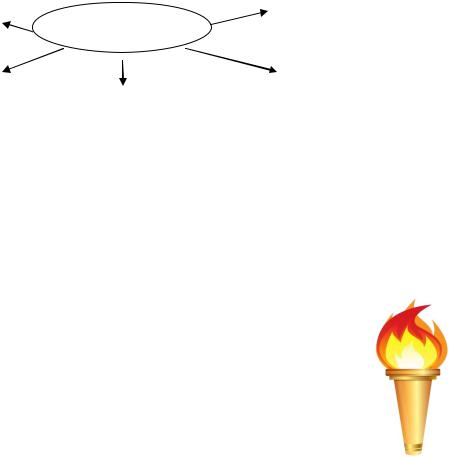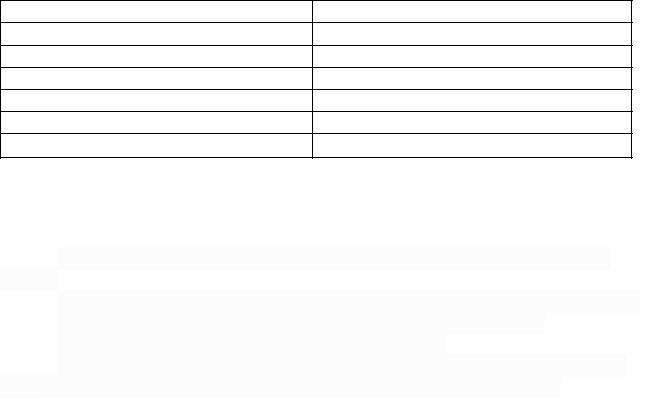
Методическое пособие 651
.pdf
Source: Business Improvement Architects. [Электронный ресурс]. – Режим доступа: URL: https://bia.ca/about-us/ (время обращения - 23.08.18).
Task 4. Match English and Russian equivalents:
1. identify |
a. терпение |
2. respond |
b. расписание |
3. objective |
c. установленный срок |
4. imply |
d. отвечать, ответ |
5. proactive |
e. вероятность, возможность |
6. schedule |
f. цель |
7. contingency |
g. определять количество |
8. quantify |
h. результат |
9. due date |
i. предвосхищающий, упреждающий |
10. outcome |
j. означать, предполагать |
11. tolerance |
k. распознавать, устанавливать |
Task 5. Find 3 pairs of antonyms in the text in Task 3. Make the sentences so that each sentence includes two antonymous words.
Task 6. Make all possible collocations:
1. |
likelihood |
a. |
plan |
2. |
gut |
b. |
commitment |
3. |
life |
c. |
marks |
4. |
schedule |
d. |
cycle |
5. |
natural |
e. |
of occurrence |
6. |
trade |
f. |
level |
7. |
contingency |
g. |
the success |
8. |
due |
h. |
feel |
9. |
tolerance |
i. |
disasters |
10.jeopardize |
j. |
date |
|
Task 7. Form all possible derivatives from the words below using the suffixes:
-ing; - ment; -ity; -able; - tion; - ful; -ly; -al.
respond |
value |
success |
nature |
manage |
accept |
like |
active |
organize |
judge |
40

Task 8. Match the sentences as True or False. Prove your choice.
1.Proper risk management is more reactive than practice.
2.Proactive management causes the team to lose valuable time.
3.Identifying risk is only a part of risk management system.
4.The purpose of risk management is to identify target customers.
5.There are more risks in the end of the project than in the beginning.
Task 9. Answer the following questions:
1.In what period of the project is risk management most needed?
2.What is the difference between active and proactive management?
3.What does acceptance of risk depend on?
4.Does risk management supplement other systems apart of problem identification?
5.What will you get by evaluating your business plan for potential problems?
6.By means of what parameters can you define the type of risk that is likely to occur?
7.When shell the process of risk management assessment take place?
Task 10. Sort out the types of risks given below into 5 categories:
|
Internal risk: |
|
|
|
|
|
Technical Risk: |
|
1. … |
|
|
TYPE OF RISK |
|
|
1. … |
|
2…. |
|
|
|
|
|
|
|
|
|
|
|
|
|
|
|
|
|
|
|
|
|
|
|
External Risk: |
|
|
|
|
|
Legal Risk: |
|
|
|
Predictable Risk: |
||||
|
1. … |
|
|
|
|
1. … |
|
|
|
|
|
1. … |
|
|
2. … |
|
|
|
|||||
|
|
|
|
|
|
|
|
|
|
|
|
|
|
|
|
Vandalism, sabotage or unpredicted side effects; litigation due to tort law; problems with team members; sued for breach of contract; poorly organized project office; media; risk stemming from design process: currency rate fluctuations.
Source: Business Improvement Architects. [Электронный ресурс]. – Режим доступа: URL: https://bia.ca/about-us/ (время обращения - 23.08.18).
Risk Management in Action
Look up the company in any sector that you like and analyze all possible types of risks that may occur. Offer the risk management plan.
41

UNIT 8
INFORMATION MANAGEMENT TECHNOLOGY (IMT)
Task 1. Discuss the following questions:
1)What computer technology should be used in a business in the start up?
2)What computer programs simplify the process of business management?
3)Are there any aspects in business that are better
sorted out by a) machines; b) people?
Task2.Readand memorizethewordsbelow thatwillhelpyouunderstandthetext.
1.umbrella[ʌmˈbrelə]term-наиболееширокаяноминацияфактов,явленийит.п.
2.consider [kənˈsɪdə]-– считать
3.selection [sɪˈlɛkʃ(ə)n]-– выбор
4.distribution [dɪstrɪˈbjuːʃ(ə)n]- – распределение
5.efficiency [ɪˈfɪʃ(ə)nsi]– эффективность
6.application [aplɪˈkeɪʃ(ə)n]– применение
7.multiply [ˈmʌltɪplʌɪ] –приумножать
8.capture [ˈkaptʃə]–захватывать
9.enterprise resource [rɪˈsɔːs] management – управление ресурсами предприятия
10.enterprise relationship [rɪˈleɪʃ(ə)nʃɪp] management – управление ресурсами предприятия
11.enterprise records [rɪˈkɔːdz] management - управление документацией предприятия
12.enforcement [ɪnˈfɔːsm(ə)nt]– усиление, укрепление
13.purchase [ˈpəːtʃɪs]- покупать
14.encompass [ɪnˈkʌmpəs] –охватывать
15.simplicity [sɪmˈplɪsɪti]– простота
16.house [haʊs] – вмещать
17.bachelor [batʃələ]ˈ – бакалавр
18.major [ˈmeɪdʒə] – основной предмет специализации
19.assessment [əˈsɛsmənt] – оценка
20.data [ˈdeɪtə] scientist [ˈsʌɪəntɪst] – специалисты по базам данных
21.knowledge [ˈnɒlɪdʒ] worker – работник умственного труда
Task3.Readthetextleading intheissueofInformationManagementTechnology. Information Management Technology (IMT)
Information management technology (IMT) is an umbrella term for the processes, systems, hardware and software a company uses to conduct its day-to-day opera-
42
tions. Information management technology is also considered to be a professional discipline where a student learns to manage the selection, distribution and organization of all the technology and related process in a business environment. Information management technology is often seen as a driver of organizational efficiency as technology has traditionally helped workers to be more productive with it than without it.
As the applications of technology in business have multiplied, information management technology has been further segmented into more meaningful categories that capture the function of the technology being used. This includes the enterprise class IMT like enterprise resource management, enterprise relationship management and enterprise records management. Any one of these sub-categories refers to a functional system that depends on hardware (computers, terminals, sensors, etc.), process (training, auditing, enforcement) and software. A large corporation will be running many of these systems, some of which will be purchased and some which are proprietary. The budget line encompassing all those systems and the costs of setting them up and maintaining them will be, for simplicities sake, information management technology. Information management technology is also referred to as information technology (IT) andinformation managementandtechnology.
Information management technology is, as mentioned, a discipline as well as a corporate function. It is often housed under a science program, but it can be part of a disciplinary specialty like a bachelor of health administration with a major in information management technology. Generally speaking, these programs will cover:
Project management
Data security and role management
Data organization and analysis
Systems analysis, design and organization
Software and hardware assessment
There are also many specialties within information management and technology when it is considered as a career.
Data scientists, for example, work with different data sources and sets to create insights, metrics and key performance indicators. Computer network architects handle the creation and maintenance of a business`s network, including administering remote access. Computer hardware engineers design hardware and configure machines in ways that optimize them for their specific function. Workers in information management technology are considered to be a part of the highly skilled workforce and are sometimes referred to as knowledge workers.
Source: Investopedia, [Электронный ресурс]. – Режим доступа: URL: https://www.investopedia.com/terms/i/information-management-technology-imt.asp (время обращения - 23.08.18).
43

Task 4. Match English and Russian equivalents:
1. |
hardware |
a. окружающая среда |
2. |
software |
b. предприятие |
3. |
environment |
c. аппаратная часть |
4. |
application |
d. покупка |
5. |
enterprise |
e. программное обеспечение |
6. |
refer |
f. применение |
7. |
purchase |
g. иметь отношение к чему-то |
Task 5. Make the derivatives out of the words below so that they fit the gaps:
Distribution, organization, productive, functional, simplicity.
1.Sheistheleaderofan international… devotedtotheprotectionofnaturalresources.
2.Thetendencyofmost computerindustryistoprovide…andcomforttotheusers.
3.The outline of the office should be not only modern, but also … .
4.The Russian government centralized the … of food.
5.The learning process was really … as the curriculum was based on the combination of practical and creative tasks and it ended up with many projects.
Task 6. Answer the following questions:
1.What is IMT?
2.What does the enterprise class IMT include?
3.What`s hardware?
4.What does IMT budget line encompass?
5.Workers in Information Management Technology sphere are knowledgeable workers, aren`t they?
Task 7. Match the sentences as True or False. Prove your choice.
1.IT provides the efficiency of enterprise productivity.
2.IMT as a career consists of many specialties.
3.Computer network architects design hardware and configure machines.
Task 8. Put the ideas below in the order they are given in the text:
a)IMT combines business environment and technology.
b)IMT is a driver to enterprise efficiency.
44

c)IMT captures some more meaningful categories.
d)IMT Is a part of a disciplinary specialty.
e)IMT presupposes many specialists.
IMT in Action
a)What business software have you already used? What is its function? In what way does it optimize the work?
b)Imagine that you are a programmer and make a program that will contribute to your enterprise work efficiency. Present your software to the class: speak about the following: its main goal, functions, results it gives, the area of its use, etc.
Task 9. Read the following text and answer the questions below:
1)What is the function of ERP?
2)What does “shared database” practically mean?
3)What are the advantages of synchronized reporting?
4)What information does dashboard offer?
5)What does modern ERP programme encompass?
ERP INTEGRATES PROCESSES ACROSS BUSINESS FUNCTIONS
ERP is an acronym for Enterprise Resource Planning, but even its full name doesn't shed much light on what ERP is or what it does. For that, you need to take a step back and think about all of the various processes that are essential to running a business, including inventory and order management, accounting, human resources, customer relationship management (CRM), and beyond. At its most basic level, ERP software integrates these various functions into one complete system to
streamline processes and information across the entire organization.
The central feature of all ERP systems is a shared database that supports multiple functions used by different business units. In practice, this means that employees in different divisions - or example, accounting and sales - can rely on the same information for their specific needs.
ERP software also offers some degree of synchronized reporting and automation. Instead of forcing employees to maintain separate databases and spreadsheets that have to be manually merged to generate reports, some ERP solutions allow staff
45
to pull reports from one system. For instance, with sales orders automatically flowing into the financial system without any manual re-keying*, the order management department can process orders more quickly and accurately, and the finance department can close the books faster. Other common ERP features include a portal or dashboard to enable employees to quickly understand the business' performance on key metrics.
Today, ERP has expanded to encompass business intelligence (BI) while also handling "front-office" functions such as sales force automation (SFA), marketing automation and ecommerce. With these product advancements and the success stories coming out of these systems, companies in a broad range of industries - from wholesale distribution to ecommerce - use ERP solutions.
Source: Oracle Netsuit, [Электронный ресурс]. – Режим доступа: URL: http://www.netsuite.com/portal/resource/articles/erp/what-is-erp.shtml (время обращения - 05.01.19).
re-keying* — повторный ввод с клавиатуры
Task 10. Replace the words in bold with their synonyms:
release, accountancy, optimize, precisely, work, functions, include, connected, developments, manage.
Task 11. Choose the sentence that better summarises the main idea of the text:
1)ERP offers staff to use the same reports.
2)ERP provides the informational resources for business to make it work more effectively.
3)ERP fastens the production process.
Task 12. Summarise the information that you know about ERP programmes. The expressions below will help you make in better structured:
ERP concerns the idea of…; to start with; As for its advantages, …; Moreover, …; Also, …; Besides, … ; For example,… ; All in all, …;
46

REVISION. UNITS 5-8
1. Do the crossword puzzle below, containing the vocabulary from the Units 4-8:
13 8 10









6
7
15


 12
12 14
14

3
5 |
|
|
|
|
|
|
2 |
1  9
9 
4 
11








Создан cовместно с Кроссгеном на сайте Биоуроки, [Электронный ресурс]. – Режим доступа: URL: http://biouroki.ru/workshop/crossgen.html (время обращения – 20.08.2017).
Across: |
Down: |
1. people in general (N.) |
|
4. The graphical representation of something |
2. the measured or measurable period during |
(N. Pl.) |
which an action, process, or condition exists or |
5. quick and ready insight, immediate appre- |
continues (N.) |
hension of smth. without immediate proof (N.) |
3. the effort of two or more parties to be better |
7.plan or tactics chosen by an enterprise (N.) |
and to achieve more than the other one (N.) |
10. a means of guaranteeing protection or safe- |
6. power to influence or command thought, |
ty (person, business, property) (N.) |
opinion, or behavior (N.) |
11. something serving as a model (N.) |
8. The money that you pay to possess smth. |
12. a device used to measure performance of a |
(N.) |
worker within some time limit (N.) |
13. The attitude between people, public, staff |
14. The synonym to director, boss, the head of |
etc. (N.) |
a company (N.) |
|
15. Material or spiritual satisfaction (payment, |
|
acknowledgement, etc.) (N.) |
|
47

Source: Merriam-Webster. [Электронный ресурс]. – Режим доступа: URL: https://www.merriamwebster.com (время обращения – 24.08.2017).
2. Use the words in the box to complete the paragraph below. Notice that the stresses syllable changes in this group of words.
Verb |
Nouns |
Adjectives |
e`conomize |
e`conomy |
eco`nomic |
|
econ`omics |
econ`omical |
|
e`conomists |
unecon`omical |
Pollution and Market Solutions
Most people today agree that we ought to be as 1) … as possible in our use of natural resources, particularly energy, and to limit pollution to a minimum. Ecologists sometimes argue that manufacturers should either clean up their production process, i.e. limit the amount of waste and emissions they produce, or be forced to close down. Manufacturers often reply that this is frequently 2) … to clean up, and impossible for their competitors do not face the same constraints. Furthermore, if all polluting industries were closed down, the 3) … would quite simply collapse. They suggest that many ecologists are simply ignorant or naïve when it comes to 4) …. Some 5) …suggest applying market solutions, i.e. finding a way to give financial rewards to producers who 6) … in the use of taxes. Many ecologists disagree, as they see pollution as a moral issue rather than an 7) … one.
Source: Ian MacKenzie, A course for Business Studies and Economics students. — 2nd edition. — Cambridge University Press, 2002. — 206 p.p. 164.
UNIT 9
THE IMPACT OF CULTURE ON BUSINESS
Task 1. Discuss the following questions:
1.What are advantages or disadvantages of culture influence to the business relations?
2.What cultural differences are particularly important for successful contact establishment?
3.What is the influence of globalization on business relations?
Task2.Readand memorizethewordsbelow thatwillhelpyouunderstandthetext.
1.cultural biases [ˈkʌltʃərəl ˈbaɪəsɪz] – культурные тенденции развития
2.circumstances [ˈsɜːkəmstənsɪz] - условия
3.well-intended [wel ɪnˈtɛndɪd] – имеющий хорошие намерения
48
4. pay-for-performance [peɪ fə pəˈfɔːm(ə)ns] – начисление зарплаты в зависимости от качества работы
5.failure [ˈfeɪljə]- неудача
6.sequence [ˈsiːkw(ə)ns] – последовательность, порядок действий
7.premises [ˈprɛmɪsɪz ] – служебное здание, зд. – условия работы
8.authority [ɔːˈθɒrɪti] – власть
9.good fellowship [ˈfɛlə(ʊ)ʃɪp] – хорошие взаимоотношения
10.verification [ˌvɛrɪfɪˈkeɪʃ(ə)n] – контроль, проверка
11.accountability [əˌkaʊntəˈbɪlɪti] – ответственность
12.accustomed conduct [əˈkʌstəmd kənˈdʌkt] – общепринятое поведение
13.consider [kənˈsɪdə] – рассматривать, обдумывать
14.mean [miːn] - значить
15.essence [ˈɛs(ə)ns] - сущность
16.novel product [ˈnɒv(ə)l ˈprɒdʌkt ] - товар-новинка
17.allegiance [əˈliːdʒ(ə)ns] – верность, преданность
18.increases [ɪnˈkriːs] - увеличивать
19.legislation [lɛdʒɪsˈleɪʃ(ə)n] – законодательство
20.consistency [kənˈsɪst(ə)nsi] – последовательность, согласованность
21.success [səkˈsɛs] - успех
Task 3. Read the text about the issue of Information Management Technology.
The Impact of Culture on Business
The new generation of international managers are educated according to the most modern managers philosophies. But just how universal are these management solutions? Are these “truths” about what effective management really is: truths that can be applied anywhere, under any circumstances? Even with experienced international companies, many well-intended “universal” applications of management theory have turned out badly. For example, pay-for-performance has in many instances been a failure on the African continent because there are particular, though unspoken, rules about the sequence and timing of reward and promotions.
International managers must operate on a number of different premises at any one time. These premises arise from their culture of origin, the culture in which they are working and the culture of the organization which employs them. In every culture in the world such phenomena as authority, bureaucracy, creativity, good fellowship, verification and accountability are experienced in different ways. That we use the same words to describe them tends to make us unaware that our cultural biases and our accustomed conduct may not be appropriate, or shared. There is a theory that internationalization will create, or at least lead to, a common culture worldwide. This would make the life of international managers much simpler. People point to
49
